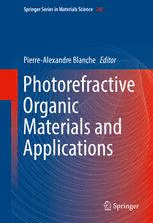
Photorefractive Organic Materials and Applications PDF
Preview Photorefractive Organic Materials and Applications
Springer Series in Materials Science 240 Pierre-Alexandre Blanche E ditor Photorefractive Organic Materials and Applications Springer Series in Materials Science Volume 240 SeriesEditors RobertHull,Charlottesville,USA ChennupatiJagadish,Canberra,Australia YoshiyukiKawazoe,Sendai,Japan RichardM.Osgood,NewYork,USA Ju¨rgenParisi,Oldenburg,Germany Tae-YeonSeong,Seoul,Korea,Republicof Shin-ichiUchida,Tokyo,Japan ZhimingM.Wang,Chengdu,China More information about this series at http://www.springer.com/series/856 TheSpringerSeriesinMaterialsSciencecoversthecompletespectrumofmaterials physics,includingfundamentalprinciples,physicalproperties,materialstheoryand design.Recognizingtheincreasingimportanceofmaterialsscienceinfuturedevice technologies,thebooktitlesinthisseriesreflectthestate-of-the-artinunderstanding andcontrollingthestructureandpropertiesofallimportantclassesofmaterials. Pierre-Alexandre Blanche Editor Photorefractive Organic Materials and Applications Editor Pierre-AlexandreBlanche CollegeofOpticalSciences UniversityofArizona Tucson,AZ,USA ISSN0933-033X ISSN2196-2812 (electronic) SpringerSeriesinMaterialsScience ISBN978-3-319-29332-5 ISBN978-3-319-29334-9 (eBook) DOI10.1007/978-3-319-29334-9 LibraryofCongressControlNumber:2016941226 ©SpringerInternationalPublishingSwitzerland2016 Thisworkissubjecttocopyright.AllrightsarereservedbythePublisher,whetherthewholeorpartof the material is concerned, specifically the rights of translation, reprinting, reuse of illustrations, recitation, broadcasting, reproduction on microfilms or in any other physical way, and transmission or information storage and retrieval, electronic adaptation, computer software, or by similar or dissimilarmethodologynowknownorhereafterdeveloped. The use of general descriptive names, registered names, trademarks, service marks, etc. in this publicationdoesnotimply,evenintheabsenceofaspecificstatement,thatsuchnamesareexempt fromtherelevantprotectivelawsandregulationsandthereforefreeforgeneraluse. Thepublisher,theauthorsandtheeditorsaresafetoassumethattheadviceandinformationinthis book are believed to be true and accurate at the date of publication. Neither the publisher nor the authors or the editors give a warranty, express or implied, with respect to the material contained hereinorforanyerrorsoromissionsthatmayhavebeenmade. Printedonacid-freepaper ThisSpringerimprintispublishedbySpringerNature TheregisteredcompanyisSpringerInternationalPublishingAGSwitzerland Preface Iwasintroducedtothephotorefractiveeffectinorganiccompoundsin1994whenI started my career at the Centre Spatial de Liege (Belgium). The objective of the program was to develop nondestructive testing technology to analyze aerospace structuresandpayloads.Atthetime,thatclassofmaterialshadjustbeendiscovered andwasascientifichottopic.Whilethesciencewasinteresting,thefiguresofmerit ofthematerialsweremarginal,and,unfortunatelyforme,noapplicationcouldbe developedintheshortdurationoftheproject. LeavingBelgiumfortheUnitedStates,Ihadthechancetoworkwithoneofthe most active groups in the field of photorefractive polymers at the University of Arizona. There, Professors Peyghambarian and Marder had assembled a team of scientistsrangingthespanfromorganicchemistrythroughopticalcharacterization andtheoreticalmodeling.Thatkindofteamformedthecriticalmassnecessaryto makesignificantadvancesinscience.Duringthattime,Iwitnessedthediffraction efficiency and sensitivity of the material multiplied a hundredfold, while the response time decreased by the same order of magnitude. Compositions were being optimized for different regions of the spectrum where proof-of-concept applicationsweredemonstrated.Theorieswereformulatedtoexplainthebehaviors observedinthelaboratory,andthepredictionsofthesetheorieswerebeingtestedin quasirealtime.Thankstothateffort,andmanysimilaronesallaroundtheworld, photorefractiveorganicmaterialsarenowfairlywellunderstoodfromatheoretical point of view and their properties substantially more developed than they were a decadeago. Today, it is possible tosynthesizea stable photorefractivecompound with close to 100% diffraction efficiency, several hundred cm(cid:1)1 of gain, and sub-millisecondresponsetime. Thefirstchapterofthisbook(BlancheandLynn)providesascientifichistoryof these exciting discoveries, from mathematical modeling to the development of specificorganicmoleculesandcompounds,aswellasthemanufacturingofreliable devices andcharacterizationprocedures.Labeledasanintroduction,itisanover- view of the techniques and progress the field of photorefractive material has experiencedthelast25years. v vi Preface The second chapter (Fuentes-Hernandez) focuses on the photoconductivity property of organic semiconductors. Not entirely specific to the photorefractive process,photoconductivityisalsoanextremelyimportantaspectinorganicphoto- voltaics,organiclight-emittingdiodes,andorganicphotoconductors,whichmakes thischapterveryimportantforawidevarietyofapplications. Building on the theoretical bases laid down by the second chapter, the third chapter(TsutsumiandKinashi)providesadetaileddiscussionofphotoconduction inphotorefractiveorganicmaterial.Morespecifically,theauthorsfocusontheuse ofthe photoconductivity tooptimize response time andsensitivity, which are two fundamental figures of merit of photorefractive organic materials that are still activelyinvestigatedtoday. The first three chapters cover what can be considered as “classical” photorefractiveorganicmaterials.Thefollowingthreepresentmore“exotic”com- positions and configurations. Diving into the core of materials science, the fourth chapter(VannikovandGrishina)detailsthephotorefractivepropertiesofpolymer composites based on carbon nanotubes. The nanotubes, in addition of being a sensitizer, also have a high degree of third-order polarizability that allows them to act as a chromophore. Based on these properties, polymer composites with photorefractivesensitivityinthenear-IRregionweredeveloped. Liquidcrystals, especiallyinthe smectic mesophases,arethe focusofthe fifth chapter(TermineandGolemme),whichprovidesadescriptionofthestructureand electro-optical properties of the different mesophases, followed by an account of theirphotorefractiveproperties. Thisnaturallyleadstotheanalysisofhybridphotorefractivesystemsinthesixth chapter (Evans,Cook,Reshetnyak,Liebig, Basun,andBanerjee)whereinorganic windows are used along with liquid crystals to enhance some of the relevant propertiesofbothmaterials. The final part of the book switches gears to focus on applications. Chapter 7 (Banerjee,Evans,andLiebig)describesthewavemixingprocessinphotorefractive polymers, including an extensive theoretical section on the material in the steady state. This study leads to the modeling of the phase shift between the intensity gratingandtheinducedrefractiveindexgrating.Thechapteralsodiscussesseveral imageprocessingapplicationsbasedonwavemixing. The loop will be fully closed with the eighth chapter (Georges) that ends the bookwhereIstartedmycareer:withtheapplicationofphotorefractivematerialsfor holographicinterferometryandnondestructivetesting.Whatwasonlyaconceptin 1994 is now routinely used by the industry, and multiple instruments have been engineered. The chapter not only exposes the techniques but also the material requirementsandthefutureprospectsforapplications. Iwouldliketosincerelythankalltheauthorsfortheircontributiontothisbook, aswellasallthepastandpresentresearchersthathaveparticipatedtobuildupthe knowledge of photorefractive organic materials that we are seeing today. We are reallystandingontheshouldersofgiants. Tucson,AZ Pierre-AlexandreBlanche October2015 Contents 1 IntroductiontothePhotorefractiveEffectinPolymers. . . . . . . . . . 1 Pierre-AlexandreBlancheandBrittanyLynn 2 ChargeTransportandPhotogenerationinOrganic Semiconductors:PhotorefractivesandBeyond. . . . . . . . . . . . . . . . . 65 CanekFuentes-Hernandez 3 PhotorefractiveResponse:AnApproachfromthe PhotoconductiveProperties. . . . . . . . . . . . . . . . . . . . . . . . . . . . . . . 129 NaotoTsutsumiandKenjiKinashi 4 PhotorefractivePropertiesofPolymerComposites BasedonCarbonNanotubes. . . . . . . . . . . . . . . . . . . . . . . . . . . . . . . 157 AnatolyV.VannikovandAntoninaD.Grishina 5 PhotorefractiveSmecticMesophases. . . . . . . . . . . . . . . . . . . . . . . . 187 RobertoTermineandAttilioGolemme 6 Inorganic–OrganicPhotorefractiveHybrids. . . . . . .. . . . . . . . . .. . 223 DeanR.Evans,GaryCook,VictorYu.Reshetnyak, CarlM.Liebig,SergeyA.Basun,andParthaP.Banerjee 7 WaveMixinginPhotorefractivePolymers:Modeling andSelectedApplications. . . . . . . . . . . . . . . . . . . . . . . . . . . . . . . . . 249 ParthaP.Banerjee,DeanR.Evans,andCarlM.Liebig 8 PhotorefractivesforHolographicInterferometry andNondestructiveTesting. . . . . . . . . . . . . . . . . . . . . . . . . . . . . . . 283 MarcGeorges Index. . . . . . . . . . . . . . . . . . . . . . . . . . . . . . . . . . . . . . . . . . . . . . . . . . . 313 vii Contributors Partha P. Banerjee Electro-Optics Program, Department of Electrical and ComputerEngineering,UniversityofDayton,Dayton,OH,USA Sergey A. Basun Air Force Research Laboratory, Wright Patterson Air Force Base,Dayton,OH,USAandAzimuthCorporation,Dayton,OH,USA Pierre-Alexandre Blanche College of Optical Sciences, University of Arizona, Tucson,AZ,USA Gary Cook Air Force Research Laboratory, Wright Patterson Air Force Base, Dayton,OH,USA DeanR.Evans AirForceResearchLaboratory,WrightPattersonAirForceBase, Dayton,OH,USA Canek Fuentes-Hernandez Center for Organic Photonics and Electronics (COPE), School of Electrical and Computer Engineering, Georgia Institute of Technology,Atlanta,GA,USA MarcGeorges Universite´ deLie`ge,CentreSpatialdeLie`ge,Angleur,Belgium AttilioGolemme DipartimentodiFisica,Universit(cid:1)adellaCalabria,Rende,Italy AntoninaD.Grishina FrumkinInstituteofPhysicalChemistryandElectrochem- istry,RussianAcademyofSciences,Moscow,Russia Kenji Kinashi Faculty of Materials Science and Engineering, Kyoto Institute of Technology,Matsugasaki,Sakyo,Kyoto,Japan CarlM.Liebig AirForceResearchLaboratory,WrightPattersonAirForceBase, Dayton,OH,USA ix
